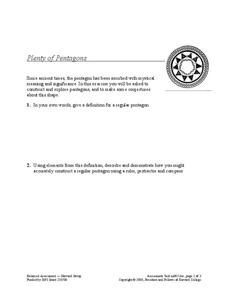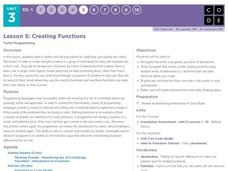Florida Center for Reading Research
Phonological Awareness: Phoneme Isolating, Phoneme Quest
In this phonics activity, little learners glue picture cards under the initial, medial, and final phonemes represented by the lead sound cards. An image of a shark broken into three parts represents the initial phoneme /sh/, the medial...
Curated OER
Tetrahedral Dice
Put those thinking hats on and look at all the possible outcomes from rolling two different four-sided dice. The challenge in this problem is finding all the combinations when adding and subtracting the numbers from each die and creating...
Balanced Assessment
Plenty of Pentagons
Why are only four colors needed to color webs from regular pentagons, not five? An assessment task requires young mathematicians to first construct regular pentagons using a compass and straightedge, then has them consider a shape...
Star Wars in the Classroom
"Shakespeare and Star Wars": Lesson Plan Days 8 and 9
How does an author's choice of artistic medium influence an audience? What about how an author chooses to transform original source material? These are the questions class members grapple with as they compare scenes from episode IV...
BW Walch
Solving Exponential Equations
Introducing exponential equations means learners need to take all the rules and tricks they learned for exponents and actually apply them. This presentation comes to the rescue by touching on changing bases in exponential...
Columbus City Schools
Sedimentary Rocks
Turn your class discussion of rock formation from ho-hum to holy hornfels! Junior geologists gain experience in identifying rock types and rock origins, with an emphasis in hypothesizing the environment needed to form certain...
Granite School District
Activities that Build Number Sense
Have fun while building the number sense of young mathematicians with this list of ten-frame learning games. From developing cardinality and counting skills to learning place value and basic addition strategies, ten-frames are excellent...
The New York Times
News and News Analysis: Navigating Fact and Opinion in the Times
Help your class understand the difference between fact and opinion by exploring the New York Times homepage and articles. In pairs or small groups, pupils complete a scavenger hunt, answering the provided questions. Next, discuss the...
Code.org
Creating Functions
Quit repeating yourself ... you can make this simpler! Rather than repeating the same set of code over and over, class members learn to build and call functions in a series of challenges in App Lab. In the end, they combine...
Willow Tree
Angle Measurement
What do you create when you rotate a ray? An angle! Teach all the angle basics including naming, measuring, supplements, and complements.
Beauty and Joy of Computing
Sprite Drawing and Interaction
Discover how to program objects to move on a screen. In the second lab of a five-part unit, each learner uses block instructions to program a sprite to follow their mouse (cursor). They investigate how to use these same block...
Emergency & Community Health Outreach
Breast Cancer: Prevent, Detect, Treat
Odds are, most of the members of your class know someone who has been affected by breast cancer. Teach them more about prevention through healthy lifestyles, detection with self-testing and mammograms, and the most effective treatments...
101 Questions
Popcorn Picker
A video and popcorn, just like being at the movies! Given the dimensions of two different cylinders, scholars decide which will hold the most popcorn. They find out if their calculations are correct with the provided solution video.
American Museum of Natural History
What Do You Know About Earth?
Time to rock and roll! Young scientists test their knowledge about rocks found on Earth and what they tell scientists. A 10-question quiz focuses on the different types of rocks, how they are formed, and what they are made of.
Illustrative Mathematics
Who Has the Best Job?
Making money is important to teenagers. It is up to your apprentices to determine how much two wage earners make with their after school jobs. Participants work with a table, an equation, and a graph and compare the two workers to see...
Florida Center for Reading Research
Vocabulary: Morphemic Elements, Getting to the Root of It
Young readers learn how to get at the root of new vocabulary with this fun language arts activity. When working in pairs, children begin by matching unknown vocabulary words to their Greek or Latin roots. When all the vocabulary cards...
Positively Autism
"What to Expect on the Fourth of July" Social Story
The social story "What to Expect on the Fourth of July" not only lets learners with autism know what to expect on this very American holiday, but also explains what behaviors are appropriate when at a fireworks display or picnic.
Illustrative Mathematics
Medieval Archer
Class members determine the distance a video game character must move to shoot an arrow over a castle wall. Players determine the new equation to enter to represent the trajectory of the arrow and find all the distances the character can...
Kentucky School for the Deaf
Levels of Organization within an Ecosystem
From tiny organisms to entire biomes, young scientists examine the interdependent relationships tying all living and non-living things together with this collection of ecology resources.
Seussville
The Cat's Word Find!
Can your class find all the words that crafty cat in the hat wants them to find? Kids circle nine words in this puzzle, all of which are in Dr. Seuss's The Cat in the Hat.
Roseburg Public Schools
Library Skills and Literature
The library is such a valuable resource for kids of all ages. Help elementary readers learn all about parts of the library, text features for both fiction and nonfiction text, and different ways to find books that they want to read.
Willow Tree
Perimeter of Common Geometric Figures
Help learners understand that perimeter and circumference are one in the same. Learners apply their skills to determine the perimeter/circumference of triangles, rectangles, and circles. They then use the same strategy to find the...
Teach Engineering
Density Column Lab - Part 1
Mass and density — aren't they the same thing? This activity has groups use balance beams and water displacement to measure several objects. The pupils use the measurements to calculate the density of the objects.
EngageNY
Representing Reflections with Transformations
In the 16th lesson in the series of 32 the class uses the concept of complex multiplication to build a transformation in order to reflect across a given line in the complex plane. The lesson breaks the process of reflecting across a line...























